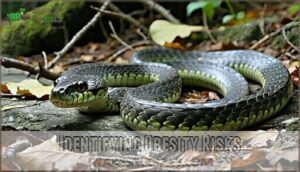This site is supported by our readers. We may earn a commission, at no cost to you, if you purchase through links.
 Snake obesity develops when you overfeed your pet or create poor habitat conditions.
Snake obesity develops when you overfeed your pet or create poor habitat conditions.
Most owners feed too frequently—snakes naturally eat large meals infrequently in the wild.
You’re also contributing to weight gain if you don’t provide proper temperature gradients, which affect your snake’s metabolism and digestion.
Inadequate environmental enrichment means less movement and energy expenditure.
Large prey items, inappropriate feeding schedules, and species-specific dietary misunderstandings compound the problem.
Your snake’s ectothermic nature means it can’t regulate body temperature like mammals, making environmental factors essential.
Recognizing early warning signs and understanding your snake’s natural feeding patterns can prevent serious health complications down the road.
It is crucial to consider the impact of poor habitat conditions and inadequate environmental enrichment on your snake’s health.
Table Of Contents
- Key Takeaways
- Snake Obesity Causes
- What Causes Snake Obesity
- Snake Metabolism Factors
- Dietary Factors Contributing
- Identifying Obesity Risks
- Frequently Asked Questions (FAQs)
- Can a snake become obese?
- What are the 5 main causes of obesity?
- How to fix an overweight snake?
- How do I get my snake to lose weight?
- Can certain snake breeds develop obesity more easily?
- How do medications influence snake metabolism rates?
- Can stress hormones contribute to reptile obesity?
- Do male and female snakes gain weight differently?
- Conclusion
Key Takeaways
- You’re overfeeding your snake – Most captive snakes receive meals weekly when they naturally eat every few weeks or months in the wild, leading to rapid weight gain and metabolic dysfunction.
- Your habitat conditions aren’t supporting proper metabolism – Without correct temperature gradients, adequate space, and climbing structures, your snake’s energy expenditure drops while its ability to regulate body temperature suffers.
- You’re choosing inappropriate prey sizes and feeding schedules – Feeding prey that’s too large or too frequent disrupts your snake’s natural feast-famine cycles and overwhelms its slower ectothermic metabolism.
- You’re not recognizing early warning signs – Physical indicators like rounded body shape, stretched scales, and behavioral changes like decreased activity signal obesity before it becomes a serious health threat.
Snake Obesity Causes
Understanding what causes snake obesity helps you provide better care for your pet reptile.
Most obesity in captive snakes stems from overfeeding practices, inadequate environmental conditions, and reduced physical activity compared to their wild counterparts.
Overfeeding Practices
Your snake’s feeding schedule shouldn’t mirror your dog’s dinner routine.
Overfeeding practices represent the primary cause of captive snake obesity, with many owners unknowingly providing weekly meals when natural feeding intervals extend months between prey captures.
Power feeding accelerates growth but halves lifespan through organ strain and metabolic dysfunction.
Understanding reptile health risks is essential for preventing these issues in snakes, related to reptile health.
Lack of Environmental Enrichment
Your pet’s cramped enclosure creates sedentary behavior patterns that mirror a couch potato’s lifestyle.
Limited enclosure space restricts natural movement, while lack of climbing structures eliminates vertical exploration opportunities.
Without environmental enrichment or stimulation, your snake’s activity levels plummet dramatically, causing a sedentary existence that reduces energy expenditure.
This results in excess calories accumulating as fat deposits throughout their body system, leading to a significant impact on their overall health due to lack of climbing structures and excess calories.
Improper Habitat Conditions
Poor habitat conditions create the perfect storm for snake obesity through multiple environmental failures.
Temperature control issues slow metabolism while inadequate enclosure size restricts movement.
Humidity levels outside 65-75% affect feeding patterns, and improper lighting disrupts natural activity cycles.
Ventilation systems must support thermoregulation – without proper habitat enrichment, your snake’s health suffers substantially.
Providing adequate environmental enrichment is essential for maintaining a healthy snake with proper thermoregulation.
Inadequate Temperature Gradients
Temperature Control becomes critical when your snake’s habitat lacks proper thermal gradients between basking and cool zones.
Heat Stress from inadequate temperature regulation substantially slows reptile weight gain by disrupting normal snake metabolism rates.
Without correct Thermal Gradients, your pet can’t thermoregulate effectively, leading to reduced energy expenditure and increased snake obesity causes.
Climate Effects and Environmental Impact from inadequate husbandry create metabolic dysfunction that promotes fat accumulation.
What Causes Snake Obesity
You’ll find that overfeeding stands as the primary culprit behind snake obesity, with captive snakes receiving meals far more frequently than their wild counterparts who naturally fast for weeks or months between feeds.
Environmental factors like inadequate temperature gradients and lack of physical enrichment compound this problem by slowing metabolism and reducing energy expenditure, which can be considered a result of captive snakes receiving improper care.
Key Benefits Overview
Understanding snake obesity causes helps you maintain your pet’s healthy weight through proper snake nutrition and obesity prevention strategies.
Recognizing metabolic health indicators allows you to implement balanced diet practices that prevent reptile weight gain.
When you understand snake feeding habits and create appropriate snake diet plans, you’re addressing the root snake obesity causes before problems develop in your reptile companion.
Common Challenges Faced
Many snake owners face significant care challenges that unknowingly contribute to snake obesity through owner mistakes and feeding errors.
Overfeeding remains the most common problem, with well-intentioned keepers providing meals too frequently or selecting oversized prey items.
Habitat issues like inadequate enclosure space restrict natural movement, while improper husbandry creates snake stress that affects metabolism and encourages weight gain causes.
Future Trends Analysis
Advanced predictive modeling and research advances are transforming reptile obesity prevention strategies for 2025.
You’ll see emerging threats like metabolic syndrome identification through AI-powered body condition scoring systems.
Snake nutrition protocols now incorporate species-specific algorithms that predict ideal feeding schedules, helping prevent snake obesity before weight gain occurs in your collection, utilizing AI-powered systems.
Snake Metabolism Factors
Your snake’s metabolism operates differently than warm-blooded pets, relying on external heat sources to regulate body temperature and energy processing.
This ectothermic system creates unique challenges where temperature fluctuations directly affect metabolic rate and fat storage patterns.
Ectothermic Regulation
Snake metabolism operates like a finely-tuned engine that runs entirely on environmental temperature control.
Your snake’s metabolic rate increases dramatically with heat – their thermoregulation system can’t generate internal warmth like mammals.
Energy expenditure drops substantially in cooler conditions, affecting metabolic function and energy balance.
Thermal cycles directly influence digestion speed and activity levels, while cold stress can severely slow essential processes, making proper temperature regulation critical for preventing obesity-related complications.
Understanding the impact of ketosis and fat burning processes is vital for maintaining a healthy metabolic balance in snakes.
Feast and Famine Cycles
Wild feeding patterns in nature create dramatic feast and famine cycles that prevent snake obesity.
Your captive snake’s metabolism expects these natural fasting periods between large meals, not weekly feeding schedules.
When you skip these essential energy storage phases, constant overfeeding disrupts normal metabolic rates, causing rapid weight gain that wild snakes never experience, due to the lack of normal metabolic rates.
Fat Storage Mechanisms
Your snake’s body stores excess energy in specialized coelomic fat bodies located within the abdominal cavity, not under the skin like mammals.
These adipose tissue deposits consist entirely of white fat cells that efficiently convert surplus calories into lipid reserves.
When energy balance tips toward overconsumption, these fat pads expand dramatically, and your pet’s slow metabolism means even small feeding increases trigger significant weight gain through enhanced lipid metabolism and fat storage.
Energy Expenditure Rates
Your snake’s metabolic rate directly impacts how efficiently it burns calories versus storing them as fat.
Unlike warm-blooded animals, reptiles can’t internally regulate body temperature, making their energy expenditure highly dependent on environmental conditions.
Understanding these metabolic factors helps prevent dangerous weight gain:
- Thermal regulation affects metabolic rates – cooler temperatures slow calorie burning
- Activity levels determine daily energy expenditure needs
- Seasonal cycles naturally reduce metabolic function during brumation periods
- Species variation creates different baseline energy requirements
- Age factors influence overall energy balance and caloric intake processing
Dietary Factors Contributing
Your snake’s diet directly determines whether it maintains a healthy weight or develops obesity through excessive caloric intake.
The combination of prey size, feeding frequency, and nutritional balance creates the foundation for either proper weight management or dangerous fat accumulation.
Prey Size and Type
Choosing appropriate prey size prevents nutritional imbalances that lead to obesity.
You should select whole prey measuring 10-15% of your snake’s body weight, with rodent size matching your pet’s thickest diameter.
Laboratory mice contain higher fat content than natural prey types, increasing overfeeding risks.
Proper prey selection and food variety help maintain healthy portion size control.
Understanding vital prey size guidelines is essential for a snake’s overall health and wellbeing.
Feeding Frequency and Patterns
Most captive snakes receive meals far too frequently compared to their wild counterparts, who naturally experience weeks between feedings.
This mismatch creates a perfect storm for weight gain when you don’t adjust your feeding schedules accordingly.
Here are five critical feeding frequency guidelines:
- Adult snakes: Feed every 14-21 days, not weekly like many owners assume
- Juveniles: Space meals 7-10 days apart to support healthy growth
- Hatchlings: Feed every 5-7 days during rapid development phases
- Seasonal adjustments: Reduce meal frequency during cooler months when metabolism slows
- Individual monitoring: Adjust feeding cycles based on your snake’s body condition and activity levels
Understanding proper snake care feeding is essential to prevent obesity in snakes.
Nutritional Requirements
Balancing protein intake and fat ratios guarantees your snake’s caloric needs align with metabolic requirements.
Proper dietary balance prevents obesity while supporting growth—juvenile snakes need higher protein levels than adults.
You’ll want to adjust diet based on activity levels, with nutrient supplements only when veterinary guidance recommends addressing specific nutritional deficiencies, ensuring a proper dietary balance.
Species Specific Diets
Different snake species have unique dietary needs that you can’t ignore.
Ball pythons thrive on rodents every 10-14 days, while corn snakes prefer varied prey selection including birds and fish.
Western Hognose snakes naturally carry more weight, making proper feeding guidelines critical to prevent overfeeding.
Understanding species nutrition prevents obesity through balanced nutrient profiles.
Identifying Obesity Risks
You’ll spot snake obesity through visual cues like rounded body shape, stretched scales, and dimpled skin texture.
Behavioral changes such as decreased activity and reluctance to move signal potential weight problems requiring immediate attention.
Physical Appearance Indicators
Obese snakes display distinctive physical appearance changes that you’ll notice through careful observation.
Their body shape becomes rounded with an indistinct spine, losing the typical tubular form. Scale condition deteriorates as persistent gaps appear between scales, revealing underlying skin texture.
You’ll feel a markedly squishy muscle tone instead of firm muscle structure. Weight trends upward create "love handles" and fat rolls during movement, making snake obesity symptoms unmistakable through these clear physical appearance indicators, characterized by a rounded body shape and deteriorated scale condition.
Behavioral Signs of Obesity
Beyond visible changes like rounded body shape, you’ll notice your snake becoming increasingly lethargic and reluctant to move.
Overweight snakes often exhibit decreased activity levels and spend more time hiding than normal. Their movement patterns become sluggish, and they may refuse food or show irregular feeding habits.
Poor shedding frequently accompanies these behavioral signs of weight gain. Recognizing these signs is vital for preventing snake obesity through proper weight management techniques, which involves proper care and weight management to prevent snake obesity and ensure healthy habits.
Regular Weight Measurements
Weight tracking becomes your most reliable tool for catching snake obesity early. You’ll need a digital scale that measures to the nearest gram, weighing your snake monthly at consistent times.
Establishing baseline measurements helps you spot gradual weight gain before it becomes problematic. To achieve accuracy, investing in a precise digital scale is vital for obtaining reliable weight measurements using a digital scale.
- Use a digital scale with 1-gram accuracy for precise readings
- Record measurements monthly on the same day each month
- Track weight alongside feeding dates to identify patterns
- Compare current weight to species-appropriate body condition standards to ensure your snake’s health and well-being, and to catch any signs of obesity early on.
Monitoring Health Trends
Looking at weight measurements over time reveals patterns that single readings can’t show.
Health checks should include monthly body condition assessments alongside scale inspection to track gradual changes.
Your snake’s weight tracking data helps identify concerning trends before obesity develops.
Fat monitoring through consistent measurements provides early warning signs, making reptile health guidance more effective for preventing snake health issues, and this is crucial for overall reptile health.
Frequently Asked Questions (FAQs)
Can a snake become obese?
Yes, you’ll find that snakes can absolutely become obese through overfeeding, inadequate exercise, and poor husbandry practices.
Captive snakes face higher obesity risks than their wild counterparts due to regular feeding schedules versus natural feast-and-famine cycles.
What are the 5 main causes of obesity?
You’ll overfeed your snake, provide inadequate exercise opportunities, maintain poor habitat conditions, follow inappropriate feeding schedules, and choose wrong prey sizes that exceed metabolic needs.
How to fix an overweight snake?
Reduce your snake’s feeding frequency to every 2-3 weeks for adults, switch to smaller prey items, and increase physical activity through environmental enrichment like climbing branches and hiding spots.
How do I get my snake to lose weight?
Decrease feeding frequency to every 2-3 weeks for adults.
Reduce prey size to match your snake’s thickest body part.
Increase environmental enrichment with climbing structures to encourage natural movement patterns.
Can certain snake breeds develop obesity more easily?
Certain breeds, certain genetics, certain metabolisms — yes, some snake species naturally develop obesity more easily than others.
Western Hognose snakes have heavier builds that owners often misinterpret, leading to overfeeding and rapid weight gain, which can be associated with their metabolisms.
How do medications influence snake metabolism rates?
Medications alter your snake’s metabolic rate primarily through temperature regulation and drug processing mechanisms.
Temperature changes affect drug metabolism, while some medications can directly slow or accelerate physiological processes, requiring adjusted dosing schedules to account for the altered metabolic rate through drug processing.
Can stress hormones contribute to reptile obesity?
Yes, you’ll find that stress hormones like cortisol can disrupt your reptile’s metabolism and feeding behaviors.
Chronic stress slows metabolic processes, reduces activity levels, and alters appetite regulation, potentially contributing to weight gain in captive snakes, which can be influenced by chronic stress.
Do male and female snakes gain weight differently?
Like two sides of the same coin, male and female snakes don’t typically show different weight gain patterns.
You’ll find that feeding frequency, prey size, and activity levels affect both sexes equally, though gravid females may temporarily appear heavier during breeding season.
Conclusion
While maintaining your snake’s health might seem overwhelming, understanding what causes snake obesity empowers you to prevent serious complications.
You’re equipped with the knowledge to recognize overfeeding patterns, optimize habitat conditions, and establish proper temperature gradients.
Your snake’s ectothermic metabolism requires careful environmental management and species-appropriate feeding schedules.
Regular monitoring, adequate enrichment, and understanding natural feast-famine cycles guarantee your pet’s long-term wellbeing and prevent obesity-related health issues.
- https://www.bva.co.uk/news-and-blog/news-article/tipping-the-scales-pet-snakes-pile-on-the-pounds-due-to-diet-and-lack-of-space-say-vets/
- https://wpvet.com/reptile-rounds/obesity-in-reptiles/
- https://www.evolutionreptiles.co.uk/blog/feeding-corn-snakes-preventing-obesity-and-promote-healthy-nutrition/
- https://www.vetlexicon.com/exotis/reptiles/nutrition/articles/obesity/
- https://thetyedyediguana.com/blog/is-obesity-unhealthy-for-snakes/















